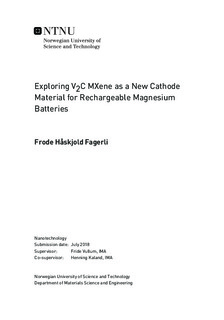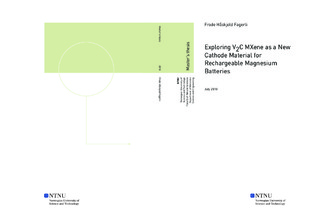| dc.description.abstract | Rechargeable magnesium batteries (RMBs) is a promising technology to compete with state-of-the art lithium-ion batteries, due to the possible improvements in safety, abundance of materials and energy density. However, one major problem with RMBs is the lack of suitable cathode materials that can host Mg-ions without trapping them. A new two-dimensional material, known as MXenes, has received increasing interest as a potential electrode material, due to its inherent high electrical conductivity and ion intercalation capabilities. In this work, one of these MXenes, namely V2C, has been synthesized and electrochemically characterized in order to evaluate it as a potential cathode material for RMBs.
First, the V2AlC MAX phase was synthesized by sintering a powder mixture of elemental V, Al, C, before the Al layer of the MAX phase was selectively etched out using a concentrated HF solution, to give multilayered V2C MXene. Some of the multilayered V2C was also treated with a tetrabutylammonium hydroxide (TBAOH) solution and delaminated. The structure, morphology and elemental content of the synthesized materials were characterized by X-ray spectroscopy (XRD), scanning electron microscopy (SEM) and energy dispersive X-ray spectroscopy (EDX). All of the active materials were then used to form cathodes, by drop casting a slurry containing the active material onto carbon paper, which later were assembled into coin cells and tested by electrochemical cycling.
The most critical aspects for obtaining phase pure V2C MXene with high yield, a suitable particle size distribution and morphology was found to be strongly dependent on the synthesis procedure of the V2AlC MAX phase, as well as the subsequent etching time and HF concentration. Using an electrolyte consisting of 0.4 M all phenyl complex solved in tetrahydrofuran (APC:THF), the different active materials showed limited cathode capacities (<4 mAh/g), indicating no significant Mg-ion intercalation into the V2C structure. The TBAOH treatment and delamination of V2C resulted in an increase of interlayer distance by 2.2 Å and reduced particle sizes, respectively, but was not found to considerably improve the cycling performance. However, with the inclusion of 0.4 M LiCl into the electrolyte (APC/LiCl:THF), the obtained capacity increased significantly (70 mAh/g after 50 cycles), demonstrating the intercalation of less charge dense Li-ions. The limited capacity obtained with the V2C MXene was attributed to high Mg-ion migration barriers, and future efforts should be directed toward lowering of these barriers, while keeping the operating potential as high as possible. With optimized termination groups, interlayer distances and morphology of the V2C particles, together with an improved electrolyte, V2C could still be a promising cathode material, enabling energy dense RMBs and hybrid Li-Mg batteries. | |

